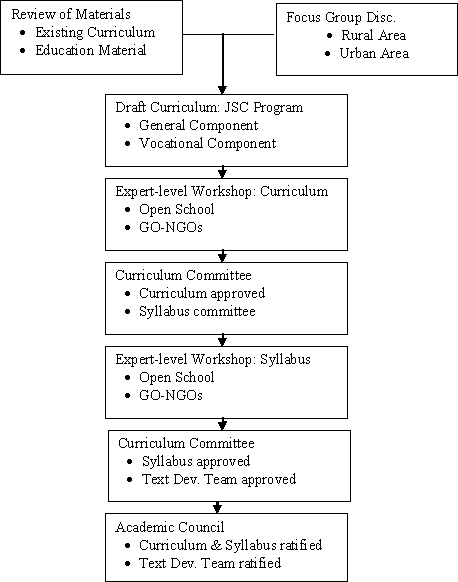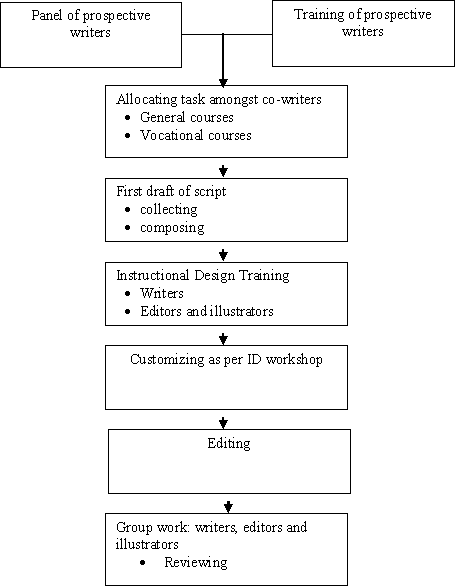|
Developing Courses of Studies for the Junior School Certificate (JSC) Programme of the Open School of Bangladesh Open University (BOU), a partnership programme with an NGO coalition, Campaign for Popular Education (CAMPE) Mizanoor Rahman, Bangladesh Open University Abstract
Open and distance Learning (ODL) has been widely used to impart education at all levels where resources are limited. In Bangladesh, of course, there is lack of recourses to provide education at all levels of formal system. Bangladesh Open University (BOU) was established in 1992 to overcome the situation as an alternative solution with a mandate of providing non-formal and need-based education and training ranging certificate to master degree level. NGO sectors have the non-formal education (NFE) programmes that already established standards of good practice. Development of NFE is very innovative. NGOs of today are not involved in charities only but in development. In the first half of the seventies, NGO activities were limited to relief and rehabilitation. After that it changes a lot. Because what relief the people had that just used to particular type of solution. In the NGO literature, it is known as stop-gap solution approach. NGOs realized that, from the mid-eighties, it is not a very effective one. That's why, NGOs changed their strategy and started experimenting with integrated community development programs. It was thought that the overall development of the community would lead to the development of poorer groups, but what had not been accounted for were structural constraints within rural societies that restricted benefits reaching the poor (Khan, 2006). It was also thought that development work should go through organizing people of the community, building awareness in them and educating them. Bangladesh Rural Advancement Committee (BRAC), the largest NGO in the world, is the pioneer in this innovation. This can be depicted as Fig. 1. Fig-1: Integrated approach of development NGOs differed from the approach developed amongst themselves and two types of interventions found. This is very much known as Prioritized Service Provision (PSP) in the NGO literature. This prioritization can be grouped as Fig. 2 Fig-2: Prioritized Service Provision (PSP) Based in large part on the success of micro-credit, this approach focuses on activities geared towards improving the economic conditions of the target group. There are, of course, many NGOs who work combining both approaches, but overall the economic one dominates. NGOs tried to link the different concepts as under (Fig. 3): Fig. 3: Linkages of micro-credit Interestingly, most NGOs in the seventies started with the more radical conscientisation model, but prioritized service provision in the eighties, contending that mobilization was difficult without economic inputs, and this along with the group mechanism, laid the foundation for ultimately empowering the poor. As per the fig. 3, NGOs link fund with increasing the quality of life of poor where education is most important in their intervention. Now, NGO programmes such as Non Formal Primary Education -- a unique model that has been replicated in different countries. This program is designed to include poor, rural drop-outs and children, particularly girls deprived of formal schooling, the Non Formal Primary Schools teach the curriculum of Bangladesh's standard five-year primary education within four years. BRAC, Dhaka Ahsania Mission, and Proshika with other local NGOs are implementing this program. For instance, BRAC has established more than 49,000 primary and pre-primary schools throughout Bangladesh, with an enrollment of over a million children, 65 percent girls (Rehma, 2006). NGO education programs have been more effective and efficient in reaching economically poorer children, particularly girls, with attendance and completion rates higher than government schools. In Bangladesh, nearly 400 NGOs run non-formal/community schools where every year nearly 10 million students are taught primary education. Most of the graduates do not have the opportunity for formal schools because of recognition problem. This drew attention to the Commonwealth of Learning (COL) and came forward to explore this as part of its technology services to the member countries. There is, of course, something to do for them. Because Open School (OS) of the BOU has the grade 9-10. The problem area is depicted in Fig-4 Fig-4: Scope of expansion of open Schooling After that the OS and NGOs with the help of the COL to develop a proposal for a pilot which was designed to demonstrate the use of a non-conventional model to provide junior secondary education to out-of-school children who have completed Grade 5 at non-formal/community schools run by NGOs. The proposal was prepared and discussed in seminars, and all indications were that there was support and enthusiasm for the initiative. Subsequently, to pilot the model the donor agencies funded the project, starting in July 2005, through the CAMPE offices. Both BOU and the NGO network has been used extensively to produce curriculum and learning materials and implement the programme, which puts emphasis on introducing vocational courses, as well as general subjects in the formal curriculum, so that when students have completed the courses they will have the opportunity for involvement in income generating activities. The Project develops the courses of studies for the Junior Secondary School (JSC) programme covering Years 6, 7 and 8. This Program relates to two prime MDGs are to reduce number of people below poverty line by 50% (by 2015) and eliminate gender disparity in primary and secondary education. In fact, Bangladesh is the only country in South Asia to have achieved gender equity in primary enrollment, in large part due to the role played by NGOs. This paper discusses the process of development of the curriculum and textual materials of the JSC programmme.
"Education from class I to class VIII must be related to work-experience and practical application of knowledge should receive greater attention than merely bookish knowledge". As mentioned earlier that completers of grade-5 do not have the opportunity for further education. Government also puts emphasis on the fact that post basic education, i.e., grades 6,7 and 8, should be managed properly because unfinished education is of no particular use later in their economic lives and they remain as a burden on their families and on society. Therefore, special need for provision for training for these drop-outs in particular vocational courses of varying duration. This stage must be regarded as the terminal stage of education for most of the students. It is not easy task to make due provision for employment for all passing out of this terminal stage of education. Many of them will become self-reliant through their own initiative have find employment for themselves. To help spread vocational education and popularize it, NGOs are the best actor in the economy. It is possible to improve fast the economic condition of the common people through the spread of vocational education. Types of vocational education now prevalent in Bangladesh is inadequate and of a low standard. Vocational education is more expensive than general education. The steps taken so far by the government expansion and improvement of vocational education are clearly inadequate. In addition, there is a great want of appropriate books in the field of vocational education and it is no exaggeration to say that such books are hardly available in Bangla. In view of the above the JSC curriculum aims: (a) to expand and consolidate the basic education given at the primary stage, (b) to develop a progressive and honest personality committed to a purposeful and well balanced life, (c) to supply the required skilled and conscientious manpower necessary to accelerate the country's economic development and (d) to prepare meritorious pupils for higher education according to their merit and inclinations. Open School used absolutely an innovative way (Fig-5) to develop curriculum
of the JSC program. A taskforce was formed consisting of members from the School,
participating NGOs, Department of NFE, Dhaka University and the Directorate
of NFE to review the existing curriculum and educational materials of the same
stage. The committee submitted a report containing the proposal of a curriculum
in a month. This committee was supported with the comments and opinions gathered
from two focus group discussions organized one in the capital city and other
in the rural area of the country. After that the proposed curriculum was presented
in the expert level workshop to have the feedbacks and based the experts' opinions,
a draft curriculum was developed and subsequently this was approved by the Curriculum
Committee. The Committee also formed the syllabus committee for each subjects
and they submitted the syllabus by seven days. Another expert level workshop
was also organized for taking opinions on the syllabus and based on the feedback;
a final draft was prepared and was approved in the curriculum committee. 3. JSC Curriculum Structure JSC Curriculum B. Vocational Courses (any 3)
The curriculum developed for this programme has concentrated in imparting vocational education along with the general education which the country needed for. Therefore, it is hoped that it will be of appreciation from the stakeholders all the time because of its emphasis on the contemporary issues in education. 4. Mapping of text development process
In order to prepare the learning materials, Open School prepares a panel of prospective writers and duly trains them up on the development of open learning materials and appoints them for writing. After the finishing of the first draft of the script, the School organizes an Instructional Design (ID) training workshop for the writers, editors and illustrators with the help of COL. As soon as the ID workshop finished, writers customize the materials as per knowledge acquired on ID issues. There are number of group work session with writers, editors and illustrators. Finally the materials are thoroughly reviewed by the subject experts/validators for printing. Therefore, text development process of the School includes:
Fig. 6: Mapping of text development
Fig. 6 depicts that the School believes in team work. This method of operation is intended to embed quality assurance procedures. Throughout the development a course, the peer group constantly monitors, discusses, and revises the draft course material, which is subjected to a process of collective criticism and development. Having work constantly scrutinized by a peer group, and being involved in learning strategies for each course, serves as ongoing staff development for all members of staff and produces high quality courses. The School is proud of its innovation in curriculum and course and programme design, and the quality assurance processes. Although the role of the course coordinator has long been established, the School is now explicitly documenting what is required to undertake this role effectively, what are the pitfalls in the course development process and how can they be avoided, and how to encourage course teams to access as much information as possible about good practice within and outside the institution. At the same time, tensions develop and trade-offs are made as the School attempts to increase the rate of course production, to use new technology to enable more frequent updates of material, and to be more innovative in every steps of the process. The objective has to be to meet these new goals without long-term loss of quality or consistency. In the Open School, it is argued that the academic staffs are committed to the team approach, and the end product, in the form of tangible course materials with integrated teaching and learning strategies, can be credited to all members of the team. 5. Conclusions 6. References Phillips, S. (2006). 'IN FOCUS: Exploring the potential of open schooling': The Commonwealth of Learning. Ministry of Law. (1973). 'Bangladesh Constitution'. Dhaka: Ministry of Law, 1973. Ministry of Education. (1973). 'Education Commission Report'. Dhaka: Ministry of Education, 1973. Asian Development Bank. (1996). 'Project Profile- Bangladesh Open University'. Dhaka: Asian Development Bank, 1996. Khan, S. (2006). 'Where Bangladesh lseads the world'. The Daily Star Net, Dhaka February 4, 2006 Rehma, K. (2006). 'The biggest NGO on Earth'. The Daily Star Net, Dhaka February 4, 2006 Figures |





